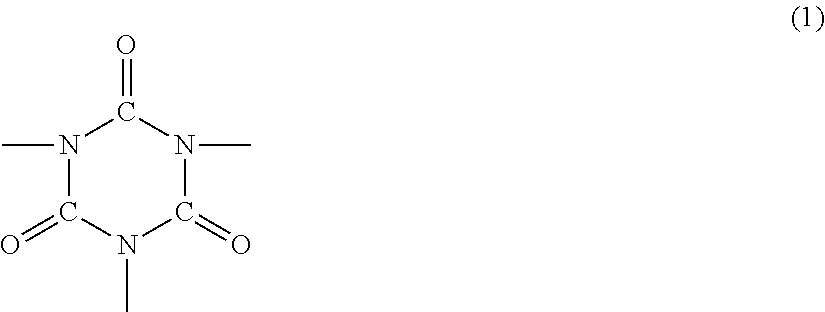Polyisocyanate cured product, and method for producing polyisocyanate cured product
a technology of polyisocyanate and cured product, which is applied in the direction of solid-state device, semiconductor/solid-state device details, coatings, etc., can solve problems such as unsuitable applications, and achieve good moisture/reflow sensitivity
- Summary
- Abstract
- Description
- Claims
- Application Information
AI Technical Summary
Benefits of technology
Problems solved by technology
Method used
Image
Examples
synthesis example 1
[0135]The inside of a four-necked flask (reactor) provided with a stirrer, a thermometer, and condenser tube was purged with nitrogen, and the reactor was charged with 500 g of HDI and 0.1 g of isobutanol. When the internal temperature of the reactor under stirring reached 70° C., 0.03 g of N,N,N-trimethyl-N-benzylammonium hydroxide as a urethanization, allophanatization, and isocyanuratization catalyst was added into the reactor. At a timing when the refractive index of the reaction solution changed by 0.010, 0.04 g of an 85% aqueous solution of phosphoric acid was added to terminate the reaction. The reaction solution was retained at 90° C. for 1 hour to completely deactivate the catalyst.
[0136]After the reaction solution was filtrated, unreacted HDI was removed from the filtrate by using a falling type thin film distillation apparatus to obtain a polyisocyanate composition.
[0137]The polyisocyanate composition obtained was a transparent liquid, and the yield, the viscosity, the NC...
synthesis example 2
[0138]The same reactor as in Synthesis Example 1 was charged with 600 g of HDI and 10 g of isobutanol, and the mixture was allowed to undergo urethanization for 1 hour with the internal temperature of the reactor under stirring set to 90° C. Thereafter, 0.01 g of tetramethylammonium capriate as an isocyanuratization catalyst was added. At a timing when the refractive index of the reaction solution changed by 0.010, 0.03 g of an 85% aqueous solution of phosphoric acid was added to terminate the reaction. The reaction solution was retained at 100° C. for 1 hour to completely deactivate the catalyst.
[0139]After the reaction solution was filtrated, unreacted HDI was removed by using a falling type thin film distillation apparatus to obtain a polyisocyanate composition.
[0140]The polyisocyanate composition obtained was a transparent liquid, and the yield, the viscosity, the NCO group content, and the number average functionality were 180 g, 700 mPa·s, 21.2% by mass, and 2.8, respectively....
synthesis example 3
[0141]The same reactor as in Synthesis Example 1 was charged with 600 g of HDI and 20 g of 3,3,5-trimethyl-1-hexanol. When the internal temperature of the reactor under stirring reached 90° C., 0.01 g of N,N,N-trimethyl-N-benzylammonium hydroxide was added into the reactor to perform urethanization reaction, allophanatization reaction, and isocyanuratization reaction. At a timing when the refractive index of the reaction solution changed by 0.007, 0.05 g of an 85% aqueous solution of phosphoric acid was added to terminate the reaction. The reaction solution was retained at 90° C. for 1 hour to completely deactivate the catalyst.
[0142]After the reaction solution was filtrated, unreacted HDI was removed from the filtrate by using a falling type thin film distillation apparatus to obtain a polyisocyanate composition.
[0143]The polyisocyanate composition obtained was a transparent liquid, and the yield, the viscosity, the NCO group content, and the number average functionality were 120 g...
PUM
| Property | Measurement | Unit |
|---|---|---|
| Temperature | aaaaa | aaaaa |
| Fraction | aaaaa | aaaaa |
| Percent by mass | aaaaa | aaaaa |
Abstract
Description
Claims
Application Information
 Login to View More
Login to View More - R&D
- Intellectual Property
- Life Sciences
- Materials
- Tech Scout
- Unparalleled Data Quality
- Higher Quality Content
- 60% Fewer Hallucinations
Browse by: Latest US Patents, China's latest patents, Technical Efficacy Thesaurus, Application Domain, Technology Topic, Popular Technical Reports.
© 2025 PatSnap. All rights reserved.Legal|Privacy policy|Modern Slavery Act Transparency Statement|Sitemap|About US| Contact US: help@patsnap.com



